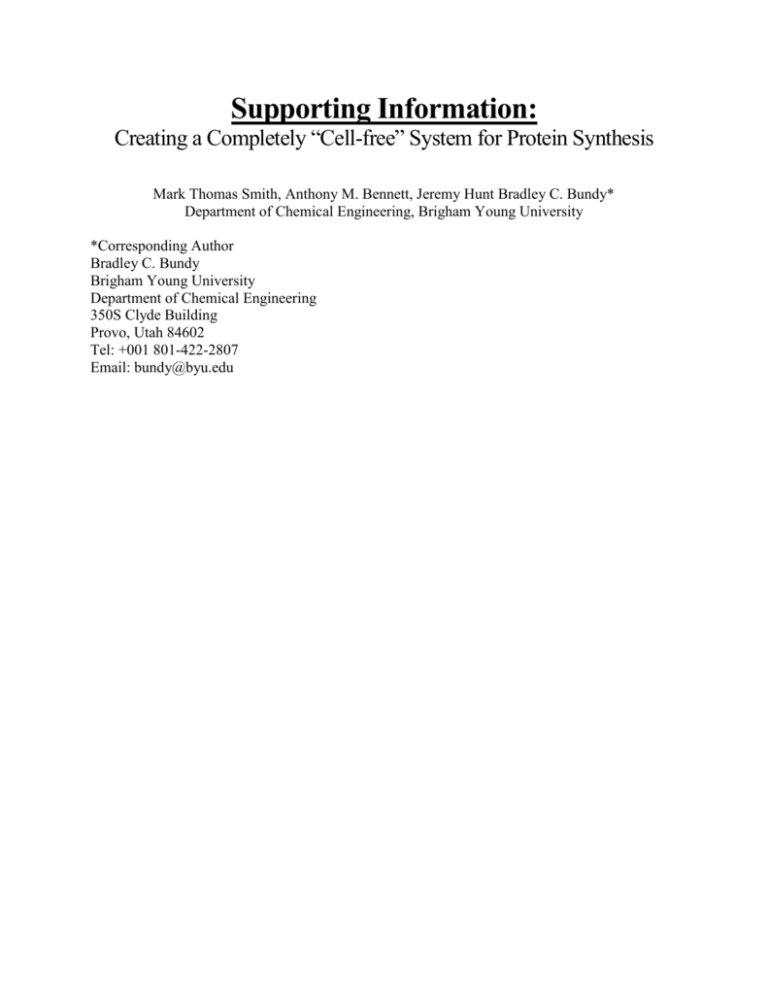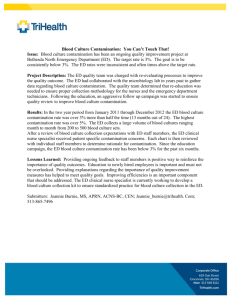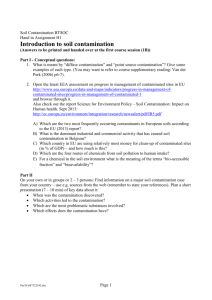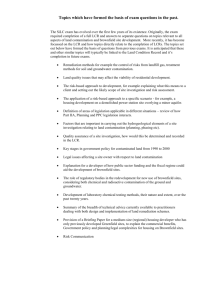btpr2157-sup-0001
advertisement

Supporting Information: Creating a Completely “Cell-free” System for Protein Synthesis Mark Thomas Smith, Anthony M. Bennett, Jeremy Hunt Bradley C. Bundy* Department of Chemical Engineering, Brigham Young University *Corresponding Author Bradley C. Bundy Brigham Young University Department of Chemical Engineering 350S Clyde Building Provo, Utah 84602 Tel: +001 801-422-2807 Email: bundy@byu.edu Normalized CFU Untreated Extract at Incubated at Elevated Temperatures 300% 250% 200% 150% 100% 50% 0% On Ice Unmixed 25 oC Mixed 37 oC Mixed Figure S1: Extract Contamination Change from Storage at 25 and 37 oC for 30 minutes. Bacteria are known to have a relatively short doubling time, typically ranging from 20-45 minutes for BL21 Star™ (DE3) under optimal fermentation conditions. End-over-end mixing of the cell extracts at room temperature was sufficient for cells to proliferate and increase contamination by 30%. At 37 oC, the cells more than doubled while mixed. Changes in Salinity Caused by Lyophilization Figure S2: Extract Salt Ion Concentration as Aqueous Volume is Removed by Lyophilizaiton High salinity is known to be deleterious to the viability of cells. For example, Hrenovic and Ivankovic reported that a 48 hour incubation of E. coli with approximately 5M NaCl in solution was sufficient to effectively eliminate all viable bacteria, a greater than 12 log-fold reduction.1 Lyophilization of cell extracts removes upwards of 98.5% of the aqueous volume, thus increases salt concentration by more than 60 times.2 Based on the ions in the buffer solution alone, this suggests an increase from ~0.16 M to greater than 10.3 M after lyophilization. This conservative estimate does not account the ions already contained in the lysed material, which would increase overall salinity. The post-lyophilization storage of cell extracts above freezing keeps the contaminating bacteria active in an extremely salty solution, and likely causes cell death.2 Vacuum and Syringe Filtration Figure S3: CFPS Yields of Filtered Extracts: Vacuum verses Syringe. A) Normalized Protein Yields. B) Normalized Contamination Both formats of filtration (vacuum and syringe) were effective at eliminating detectable bacterial contamination. On average, each performed equivalently well as the other. However, the syringefiltered extracts provided less consistency than the vacuum filtered extracts. Yield error bars = 1 stdev, n=3. UV Treatment – Normalized Yields and CFU Figure S4: UV Treatment Effects. A) Normalized protein yield after 40 min UV-254 Treatment. B) Normalized contamination at given pathlengths and treatment times. Increasing the pathlength of the treatment led to weak overall increase in bacterial contamination (regression p-value = 0.26). The weakness of the trend may be due to the extremely attenuated UV intensity that approached 90% at 2 mm and exceeds 96% attenuation by 3 mm (Figure S5). At these treatment depths, the difference in attenuation effects is limited. However, increasing incubation time led to a strong increase in contamination levels (regression p-value < 0.01). The combination of poor UV-penetration and the increased incubation time allows for the cells to propogate and increase contamination. UV is a promising technique, but implementation of this method for extract sterilization will likely require more advanced equipment and higher power UV bulbs. Yield error bars = 1 stdev, n=3. Relatively UV Intensity UV-254 nm Intensity Attenuation 1 0.1 0.01 0.001 0.0001 0.00001 0.00 0.20 0.40 0.60 0.80 Depth or Pathlength (mm) 1.00 Figure S5: Model of UV-254 Intensity Attenuation through Extract. Cell extract predominantly consists of protein, with an average of 68 mg protein per mL extract. To model the impacts of this dense solution on UV-254 intensity, we predicted the average extinction coefficient of the solution based on known parameters: 1) average length of E. coli protein: ~300 amino acids, 2) statistical probability of given amino acid based on codon bias in E. coli randomly assigned to 896 model proteins, and 3) individual extinction coefficients of amino acids that absorb UV-254 (Tyr=383, Trp=2861, His=18, Phe=143 cm-1M-1). The resulting average extinction coefficient modeled was 0.75 ± 0.19 cm-1(mg/mL)-1. At the high concentration of protein in extract, the UV-254 intensity would decrease by about 90% within 0.2 mm. In the shallowest depth tested in this work, the theoretically predicted pathlength was 1.8 mm, which corresponds to a predicted attenuation to UV-254 intensity greater than 99.9999%. This level of reduction suggests that the 1100000 µW/cm2 is reduced to 1.1 µW/cm2 at the bottom of the sample, which is insufficient to reduce the residual bacteria in the exposure times tested (up to 40 mins). Ampicillin Treatment – Normalized Yields and CFU Figure S6: Ampicillin Treatment Effects. A) Normalized CFPS yields with treated extract compared to an untreated control on ice. B) Normalized CFU with treated extracts compared to an untreated control on ice. Ampicillin was added to extracts at doses at and higher than typical culture concentration (>0.1 mg per mL). The mixtures were incubated at room temperature for 30 minutes. Extracts were subsequently assayed for contamination and protein synthesis viability. The addition of ampicillin led to a mild improvement of protein yield while reducing contamination. However, under the conditions tested, ampicillin was insufficient to effectively eliminate cell contamination. This inability to eliminate contamination may be due to factors such as insufficient treatment time. Increased treatment duration at temperatures above freezing is known to reduce protein synthesis viability. (n=3 for CFPS yields, error bars represent 1 standard deviation). Lysozyme Treatment – Normalized Yields and CFU Figure S7: Lysozyme Treatment Effects. A) Normalized CFPS yields with total extract fraction and soluble extract fraction compared to an untreated control on ice. B) Normalized CFU with treated extracts compared to an untreated control on ice. Increasing amounts of lysozyme in the extract caused a visible increase in the formation of aggregates. Therefore, we considered the total extract fraction and the soluble extract fraction after lysozyme treatment for CFPS viability. Notably, the formation of aggregates decreased yields slightly, but the centrifugal removal of aggregates virtually eliminated protein synthesis when treated with 8 mg/mL lysozyme. Lysozyme is effective at removing >70% of the bacterial contamination in the extract. However, the treatments described here are insufficient for multiple log-fold reductions in contamination. References 1. Hrenovic, J.; Ivankovic, T., Survival of Escherichia coli and Acinetobacter junii at various concentrations of sodium chloride. EurAsian Journal of Biosciences 2009, 3, 144-151. 2. Smith, M. T.; Berkheimer, S. D.; Werner, C. J.; Bundy, B. C., Lyophilized Escherichia coli-based Cell-free Systems for Robust, High-density, Long-term Storage. BioTechniques 2014, 56, (4), 186-193.







![paper_ed5_25[^]](http://s3.studylib.net/store/data/007250962_1-59e11c14b4f7017fb8eed3422c91bdcb-300x300.png)